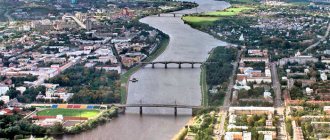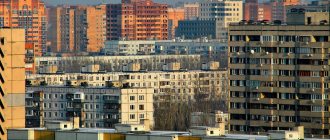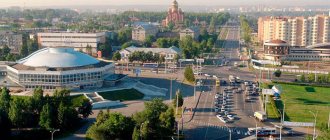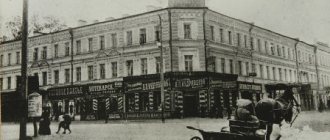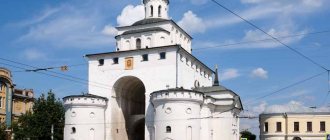How many people live in the city of Barnaul, what is the population as of January 1, 2022, what number of people live officially, is it increasing or decreasing in municipal areas, growing or vice versa, decreasing, decreasing and where?
Statistics have always interested people and no matter what it concerns, and we are interested in it for a variety of reasons, out of curiosity and for other, very different reasons, we want to know about something, for example, about a given topic, which we will deal with below.
Population census of Barnaul, how many people live on January 1?
What is the official population of Barnaul for 2022, how many people live according to the census, how many people are in urban areas as of January 1, trends in profit and loss, whether their number is increasing or decreasing, such questions are of interest to many and we will try to get answers to them.
The city of Barnaul with all its administrative districts is part of the Russian Federation, the administrative center of the Altai Territory and the urban district of the same name.
We will look into the population of the city of Barnaul, how many people live as of January 1, 2022, and how many people officially live in urban areas.
Long term impact
What will happen next? The general opinion of most experts is that mortality from COVID-19 will decrease in 2022. So 2022 was what is called the bottom - we won’t fall any deeper.
But, nevertheless, at the VEB Institute of Research and Expertise. The Russian Federation emphasizes that excess mortality will have a long-term negative impact on the Russian economy.
VEB analysts optimistically assume that Russians’ incomes will reach 2013 levels by 2024. And the growth of the working-age population in the country will resume - but only after 2025. The Analytical Credit Agency, however, believes that the demographic “footprint” of the pandemic will not disappear even 15 years after its end.
Well, we (or our descendants) will feel a reduction in the number of newborns in 25-30 years. And again, as today, the question will be asked: “Where are all the people?”
Population in municipal, urban areas
Located in the south of Western Siberia at the confluence of the Barnaulka River and the Ob. It arose in 1734-1735 and developed as a village at the silver smelter of Akinfiy Demidov.
Currently, it is a major transport hub, industrial, cultural, medical and educational center of Siberia.
It is located in the forest-steppe zone of the West Siberian Plain, in the northeast of the Priob Plateau, in the upper reaches of the Ob River, mainly on its left bank, at the confluence of the Barnaulka River and the Ob.
From the north and east, Barnaul bends around the Ob riverbed, and in the southwest - a ribbon forest.
The continental climate is determined by the peculiar geographical location in the south of Western Siberia.
Openness to the influence simultaneously from the Atlantic, the Altai Mountains, the Arctic Ocean and the steppe regions of Central Asia creates the possibility of the arrival of air masses of different properties, which contributes to a significant contrast in weather conditions.
Now we will tell those interested in the climate in the city of Barnaul, what the average temperature was according to research over the past few years, the maximum and minimum values, as well as the average and norms of precipitation:
Climate of Barnaul (weather, precipitation)
| Index | Jan. | Feb. | March | Apr. | May | June | July | Aug. | Sep. | Oct. | Nov. | Dec. | Year |
| Abs. Max. | 5,3 | 7,4 | 16,4 | 32,3 | 37,4 | 36,6 | 37,9 | 38,3 | 34,0 | 27,4 | 16,6 | 7,2 | 38,3 |
| Avg. Max. | −10,8 | −8,1 | −0,6 | 10,1 | 20,1 | 24,3 | 26,3 | 24,3 | 17,7 | 9,2 | −2,2 | −8,6 | 8,5 |
| Avg. pace. | −15,5 | −13,7 | −6,5 | 3,8 | 12,8 | 17,7 | 19,9 | 17,4 | 11,0 | 3,8 | −6,3 | −12,9 | 2,6 |
| Avg. min. | −20,1 | −18,7 | −11,8 | −1,2 | 6,5 | 11,6 | 14,0 | 11,6 | 5,6 | −0,4 | −10 | −17,4 | −2,5 |
| Abs. min. | −48,2 | −46,1 | −38,9 | −27,6 | −8,8 | −1,2 | 2,9 | 0,0 | −7,8 | −27 | −42,8 | −43,9 | −48,2 |
| Norm of siege. | 24 | 18 | 17 | 29 | 40 | 55 | 68 | 44 | 34 | 37 | 37 | 31 | 432 |
Whether the population of the city of Barnaul is decreasing or increasing, what is its official number according to the census as of January 1, 2022, in its municipalities, urban areas, we will learn about this later, when accurate information appears, but for now we will present the currently available figures.
Founding date of Barnaul: 1730
Time zone: MSK +4, UTS +7
They give birth less
According to the expert, last year was the lowest in the history of the region and the number of newborns was about 19 thousand. A year earlier, the figure was 19,840. And compared to pre-pandemic 2019, the birth rate decreased by 9%.
To understand: in 1995, a very critical year for the region, 23,338 babies were born in the region.
And in 2022, the difference between the number of deaths and births (natural decline) also turned out to be maximum - more than 24 thousand. “This led to the formation of a demographic hole in the region that was record-breaking in depth,” says Eremin.
In Russia as a whole, however, the trends are similar: mortality in 2021 increased by 15.1%, the birth rate decreased by 2.3%. The natural population decline reached 1.04 million people, RBC reported. The population decreased by almost 693 thousand people.
Coronavirus. Omicron strain.
CC0
Population gain or loss according to the census
The total and official population of the city of Barnaul, how many people live in it as of January 1, 2022, the number of people in each individual urban district and municipality, further in the second table.
| Year | Growth/decrease population city of Barnaul |
| 2017 | ↘633,301 people |
| 2018 | ↘632,372 people |
| 2019 | ↗632,723 people |
| 2020 | ↘632,391 people |
| 2021 | ↘631 124 people |
| 2022 |
Maximum after the war
Mortality reached its highest level during the pandemic in November 2021: registry offices registered 4,823 death certificates.
In December 2022, the figure fell but remained well above pre-pandemic levels: 4,215. This is 60% more than the average for the same month in 2016-2019.
In general, in 2022, according to operational data, 43.7 thousand people died in the region (in 2020 - 38 thousand) - plus 11 thousand by 2022. The governor of the region, Viktor Tomenko, commented on these sad results on the eve of the New Year: this is a record figure for the last 20 years.
Meanwhile, this is the maximum for the entire post-war period, calculated Alexey Eremin, associate professor of the department of state and municipal administration of the Altai branch of RANEPA.
Statistics.
Pixabay.com
National composition of Barnaul
| People | Number of people (%) |
| Russians | 629 271 (95,79 %) |
| Russian Germans | 6 172 (0,94 %) |
| Ukrainians | 5 301 (0,81 %) |
| Armenians | 2 690 (0,41 %) |
| Tatars | 1 547 (0,23 %) |
| Azerbaijanis | 1 488 (0,22 %) |
| Belarusians | 1 253 (0,19 %) |
| other | 9 261 (1,41 %) |
| Nationality indicated | 656 938 (100,0 %) |
| Total | 670 332 |
With the population of the city of Barnaul as of January 1, 2022, how many people live in this territory, people in municipalities and this locality, this territorial unit of the Russian Federation, that’s what we figured out here, we made our contribution to satisfying the requests of those interested in this statistical information .
Unfavorable days in 2022, difficult for health and well-being
Lunar calendar for hair cutting 2022, favorable days to cut hair
Only Covid
“The increase in mortality is associated exclusively with excess mortality from COVID-19, as well as the lack of mortality from this disease in the first four months of 2022,” Deputy Prime Minister Tatyana Golikova recently commented on the situation to RIA Novosti.
Golikova also noted that mortality from a number of other diseases in 2022, on the contrary, decreased. Other experts, however, add that the disease caused by the coronavirus can accelerate the course of a chronic disease.
In addition, there is a large category of citizens who recovered from coronavirus, but after some time died from its consequences, RBC recalls.
Altai doctors have already partly confirmed this. Thus, the chief freelance neurologist of the region, Sergei Fedyanin, said: mortality from strokes has increased in the region.
Stroke is a common disease.
pixabay.com
According to him, coronavirus infection stimulates the formation of blood clots in the cardiovascular system, and people young for this disease - 40-45 years old - began to get sick more often.
There are no official statistics on the number of patients with cardiovascular pathologies for 2022, but the doctor suggests that the increase in incidence will be at least 10-15%.
As for mortality from this category of diseases (circulatory diseases), already in 2022, according to Altai Kraistat, it jumped in the region by 18%. Information for 2022 has not yet been published.
Coronavirus. Pandemic.
CC0
Mountaineering and trekking
While the central part of the region is predominantly a low-lying and flat area with water meadows, the outlying territories of the Altai Territory, on the contrary, provide athletes with wonderful opportunities for training and real ascents to the Altai Mountains. From their peaks you can see uniquely beautiful views of the surrounding landscapes, which belong to the systems of the West Siberian Plain and the Altai-Sayan mountain system.
For those who are not ready to take risks or do not have sufficient physical fitness, local tourist guides and specialized companies offer both group ascents to low altitudes and long walking routes along mountain ridges.
Sights of the city of Barnaul
The main city of the Altai Territory is rich in various attractions, among which residents and guests of the city may be interested in a variety of objects.
Museums
- State Museum of Local Lore (46 Polzunova St., look on the map near the park of the central district in the east of the city) - in the collection there are over 150 thousand exhibits, objects of the primitive history of the region are of particular value.
- The City Museum (Lenin Ave., 6) has been operating for only about 10 years, demonstrating the history of Barnaul through the destinies of its most worthy residents.
- Beekeeping Museum (Krasnoarmeysky Prospekt, building 14/96) - the exhibition contains detailed information about bees and caring for them; visitors are offered master classes and a demonstration hive.
- Regional Museum of the History of Literature, Culture and Art (L. Tolstoy St., building 2) - over 62 thousand exhibits are stored in the storerooms, including items from the personal funds of N. Roerich and V. Shukshin. They are housed in 12 thematic rooms.
Monuments
- Monument to V.M. Shukshin (Yurina St.) - erected for the 60th anniversary of the writer and director.
- Monument to V. Tsoi - built in 2010, located on Socialist Avenue.
Temples and cathedrals
- Church of John the Evangelist (Shumakova St., 25a, according to the map it is located in the west of Barnaul in the square: Pavlovsky Tract, Malakhova St., Popov St. and Vlasikhinskaya St.) - a two-story temple, erected with donations from philanthropists and parishioners.
- Intercession Cathedral (Nikitina St., 137) - built in the 2nd half of the 19th century at the expense of the townspeople, the interior was painted based on Christian sources.
- Znamensky Monastery (Bolshaya Olonskaya St.) - was consecrated in 1908, but after a quarter of a century it was closed, thanks to the restoration it restored its original appearance.
- Church of St. Nicholas the Wonderworker (Lenin Ave., 36) - was built at the beginning of the last century as a regimental church.
- Chapel of Alexander Nevsky (Lenin Ave.) - erected in 1904, at the beginning of the 21st century it was reconstructed and acquired a higher tent.
Interesting places
- The Planetarium (Sibirsky Prospekt, 38) is the sixth planetarium in the country in terms of opening time; in the artificial sky you can see 5.8 thousand stars and many other celestial objects.
- Zoo (Entuziastov St., 10a) - has been operating since 1995, visitors can admire 140 animals of over fifty species.
- The house under the spire (Lenin Ave., 82) is one of the symbols of the city, built in the mid-20th century.
How to get to the Altai Territory?
Despite the fact that the region where Barnaul is located is characterized by its remoteness from the main financial centers of the country, it nevertheless boasts excellent transport access. You can get to the city by several means of transport, including air. However, cars are the most popular, since several major highways pass through the city, including those leading to Mongolia and Kazakhstan.
Branches of the West Siberian Railway also pass through the city. The city has a passenger station and a freight railway terminal, serving local enterprises in the mining and engineering industries.
To understand where Barnaul is located on the map, it is enough to find the Ural Mountains, to the southeast of which it is located, in close proximity to the Russian state border. Considering the position of the city, it is not surprising that Barnaul airport has international status and receives flights not only from major Russian cities, but also from the capital of Thailand - Bangkok.
History of the city name
There are several versions of the city's name. The Siberian archaeologist Alexei Umansky at one time developed a version that states that since this region was once inhabited by a small Turkic people (Teleuts), the name came from the word “porongyul”. In translation it means: “porongy” - muddy water, and “ul” - river. This version is confirmed by the fact that in fact R. Barnaulka, on the banks of which the city stands, has muddy water. It is like this because of the large amount of organic and mineral substances mixed with river sand.
In topographic maps of the 18th century, the river was called Boronoul. Professor from Tomsk Dulzon gave an explanation. He said that the name of the geographical object consists of two words - “boro” (translated from Turkic as wolf) and “ul” (river). Thus, "Wolf River".
This professor confirms with documents that wolves lived in this region.
The most reliable version is considered to be the opinion of many historians who believe that the name is associated with the Barnaulka River.
Main streets of Barnaul
A map of Barnaul with houses allows you to see each street in detail and study in detail the objects located on them. In total, in the capital of Altai there are about 780 streets, 11 avenues, 10 tracts and 126 alleys. The largest of them:
- Lenin Avenue is the central thoroughfare of Barnaul, crossing three city districts, its total length from Kosmonavtov Avenue to Sq. them. V.N. Bavarina is 8.5 km away. Here are the most important government institutions (regional and city administration, prosecutor's office, regional court, Central Internal Affairs Directorate for Altai), secondary and higher educational institutions (medical university, ASU, Altai State Technical University, college of architecture and construction), the Dynamo stadium, as well as the Solar Wind park. .
- Kalinina Avenue is one of the main streets of the city, passing through the territory of Zheleznodorozhny and Oktyabrsky districts. Length from Kosmonavtov Ave. to Sq. Oktyabrya is about 5 km, the width varies between 11-36 m. The map shows that the part of the avenue between October and Tekstilshchikov squares is divided by an alley into 2 parts. Near the street there is the Transmash stadium, the economics department of the Altai Academy of Economics and Law, the regional state art museum and the youth theater. At the confluence with Lenin Avenue it forms October Square.
- Pavlovsky tract is one of the leading city directions, connecting the outlying areas and industrial zone with the central part of Barnaul. Then, following the map, it goes to the western regions of the region, turning into the P380 . Crosses the Zheleznodorozhny and Industrial districts, length is about 14 km. By 2025, with the implementation of the approved general plan, it should turn into a central highway. The road leading to the airport departs from the highway. Near the street there is a regional car market and several shopping centers.
- Malakhova Street is one of the main transport arteries crossing Barnaul in the meridional direction. It runs through three districts of the city, its length is more than 7 km, its width is about 30 m. Tram tracks are laid along almost the entire length of the street. Many five- and nine-story buildings were built along it, at the beginning is the Motor Builders House of Culture, in the middle part is the Institute of Reproduction and Genetics, and at the end is the Vlasikhinskoe cemetery. Forms a large interchange with the Pavlovsky Highway.
- Popova Street is an important transport route of the regional capital, which runs through the Leninsky and Industrial districts. It ends in the village of Novosilikatny, the length is about 10 km. Tram traffic is organized along the entire length. In the area of the street there is a perinatal center, regional and city children's hospitals, Dokuchaevsky market, as well as People's Square.
- Vlasikhinskaya Street - runs through the Industrial and Zheleznodorozhny districts, the length is more than 8 km. Nearby is the chapel of Dmitry Donskoy and the Volna shopping center, at the end it merges into the Pavlovsky tract.
Economy and industry of Barnaul
Like any industrial center, Barnaul cannot be called an environmentally friendly city. All of its industry is concentrated in the north of Industrialny, as well as in the Oktyabrsky and Leninsky districts. These areas are shaded gray on the map.
The largest enterprises in the north and far west are AZPI, Altaidizel, Altai Instrument-Making Plant, Pump Plant, Carriage Manufacturing Plant, BShZ, Barnaul ZATI, Altaispecizdeliya, Barnaul KZ, Barnaul Rubber Products Plant, several reinforced concrete products.
Wholesale trade enterprises, markets and large retail establishments are evenly scattered throughout the city - the central market, the city wholesale base, the Dokuchaevo clothing market, the wholesale-retail and Chinese markets on Kosmonavtov Avenue, the largest trading base on Inzhenernaya Street, the Wholesale Food Market of the Altai Territory (to the east Chinese market), as well as numerous bazaars in residential areas.
In the urban core and in the south of the city, on major streets there are buildings of Russian bank branches. In the central part of Barnaul, as well as in the Leninsky and Oktyabrsky districts (where there are many business centers), there are offices of the largest construction companies.
Busy construction of houses is taking place in microdistricts and suburbs adjacent to the Ob River (they are characterized by infill development). They are taking a comprehensive approach to solving the housing problem in the west of the Industrial District. Large houses are also being built on Komsomolsky Prospekt. There are many new buildings in the southwest (on the streets of Baltiyskaya, Vlasikhinskaya and on the Pavlovsky tract, closer to the airport, a network of modern luxury residential complexes has been built).
Altai Museum of Local Lore
On Polzunov Street there is the Altai State Museum of Local Lore. It is considered the first in Western Siberia. The opening took place in 1923.
The idea belonged to the manager of mining factories in the Barnaul region, Pyotr Frolov, and the naturalist scientist Friedrich Gebler. At that time the museum was called the “Mountain Museum”.
The exhibition was based on models of mining machines and various mechanisms of mining production and an extensive collection of minerals from the Urals.
Of great interest to visitors is the inspection of the first steam engine of the Russian inventor Ivan Polzunov. In 1766, this outstanding man built the first heat engine (steam engine) in Russia, which he invented, on the banks of Barnaulka.
Tourists are given the opportunity to examine models of industrial machines of the 18th-19th centuries and other various mining equipment of those times.
Train Station
The railway station in the city of Barnaul is located at Pobeda Square, 10. The station is open 24 hours a day. There is free car parking next to the main station building. The year the railway station was built is 1914.
The most popular train directions: Biysk, Cherepanovo, Kamen-on-Obi, Rubtsovsk, Bayunovo, Aleyskaya, Alambay, Tomsk, Karasuk, Rebrikha, Novosibirsk, Omsk, Moscow, Ridder, Abakan, Adler, Novokuznetsk, Kulunda, Tashkent, Karaganda. Suburban trains also operate from the railway station. In the station building, passengers can find a cafe, a hairdresser, a waiting room, a maternity and child room, and a medical center.
Tourism and sports in Altai
The nature surrounding Barnaul contributes to the development of active recreation associated with cross-country skiing in the winter and long walks over rough terrain in the summer. The demand for active pastime prompted one of the Barnaul companies to build a special track in Ribbon Bor. The length of the route is twenty-five kilometers, and it is designed in such a way that all athletes feel comfortable and safe when skiing. It starts at the Dynamo stadium and ends there.
Barnaul, where the Health Track is located, has thus become one of several cities where new trails and tracks have been built for runners and skiers. However, it is not only skiing that attracts travelers and sports tourism enthusiasts to Altai.
Geography and climate of Altai
The region where Barnaul is located is well known for its recreational resources, which rightly include unique clean air, amazing landscapes and landscapes of stunning beauty. Many people go to the Altai Territory for solitude and peace of mind. They gain strength and get their nerves in order after living in the tiring rhythm of megacities, which is not surprising, because from Moscow to Barnaul there are almost three and a half thousand kilometers by road.
The nature in these parts is truly pristine, despite the fact that the city of Barnaul was originally a mining village serving the Demidov factories, which smelted silver from local mines. Since its founding in 1730, Barnaul has transformed from a small settlement into a large industrial and cultural center of Western Siberia.
Hotels in the city
In Barnaul there is a huge variety of hotels , hotels, hostels, cottages and overnight accommodations of different price categories. Despite the differences in price, each of the establishments meets all the sanitary minimum requirements; the only difference is the availability of swimming pools, Wi-Fi, massage rooms and other bonuses.
The table shows prices per room per night:
| Hotel | Price per room | Address | Telephone |
| "Siberia Inn" | 500 rub. | Kosmonavtov Ave., 8/2 | 8 |
| "Victoria" | 640 rub. | st. Tikhonova, 40a | 8 |
| "24 hours" | 856 rub. | st. Pionerov, 9 | 8 |
| "Tourist" | 1870 rub. | Krasnoarmeysky Ave., 72 | 8 |
| "Alexander House-Sport" | 2600 rub. | st. Privokzalnaya, 35-a | 8 |
| "Snail" | 3892 rub. | st. Korolenko, 60 | 8 |
| "Zarechye" | 5000 rub. | Pravoberezhny tract | 8 |





